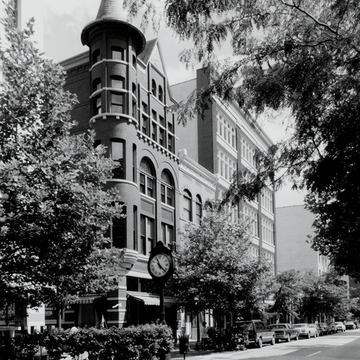Capitol Street's longest block is lined with significant structures on both sides. McCrory's (number 218), at the center of the even-numbered side, has a superb white terra-cotta “dime store” facade. Across the street is Scott's (number 227), a delightful 1892 red brick, Queen Anne confection by Columbus, Ohio, architects Yost and Packard. Its rounded, threeand-one-half-story corner turret terminates in a witch's-cap roof. Lowenstein's (number 223–225; 1900–1901), another Yost and Packard design, is a five-story brick building with classical details and a dramatically arched central bay with oriel windows. Between the two buildings, a street clock marks the entrance to Brawley Walkway, a pedestrian link between downtown and Charleston Town Center ( CH22) several blocks away. The former O. J. Morrison Department Store (number 231; 1920), now home to a mini-mall, is a five-story building that incorporates part of the 1891 Burlew Opera House in its walls. Levi J. Dean, of Huntington, company architect for Morrison's, a West Virginia department store chain, provided generous banks of windows that allowed natural light to penetrate the sales floors. Paul D. Marshall and Associates of Charleston supervised the 1980s restoration of these buildings and those facing Brawley Walkway.
You are here
200 Block of Capitol Street
If SAH Archipedia has been useful to you, please consider supporting it.
SAH Archipedia tells the story of the United States through its buildings, landscapes, and cities. This freely available resource empowers the public with authoritative knowledge that deepens their understanding and appreciation of the built environment. But the Society of Architectural Historians, which created SAH Archipedia with University of Virginia Press, needs your support to maintain the high-caliber research, writing, photography, cartography, editing, design, and programming that make SAH Archipedia a trusted online resource available to all who value the history of place, heritage tourism, and learning.

